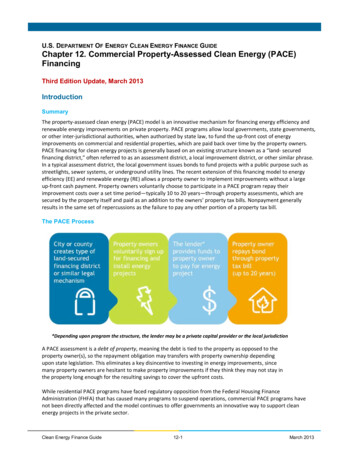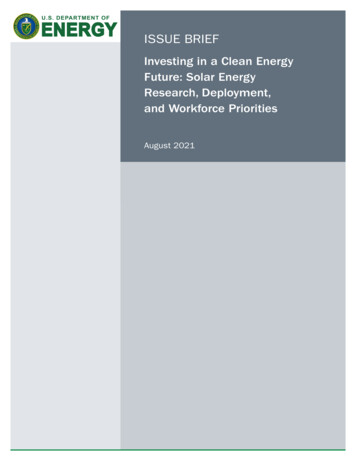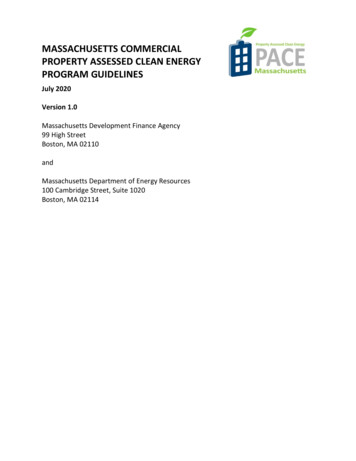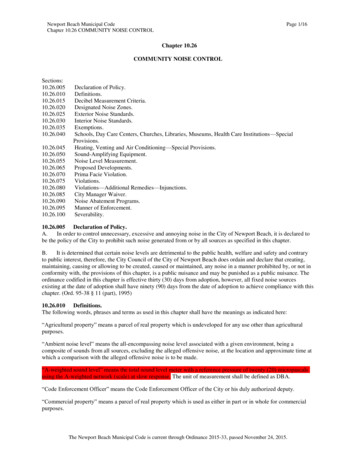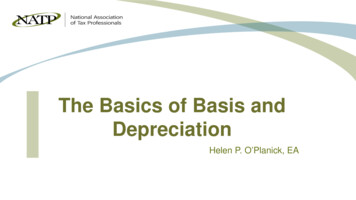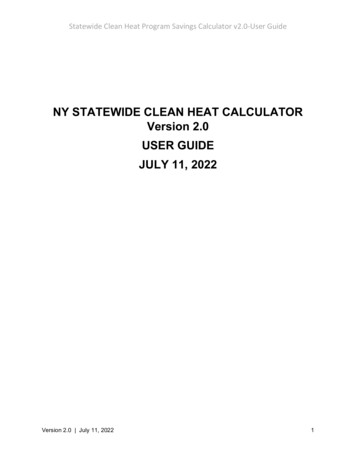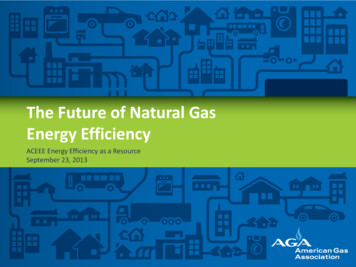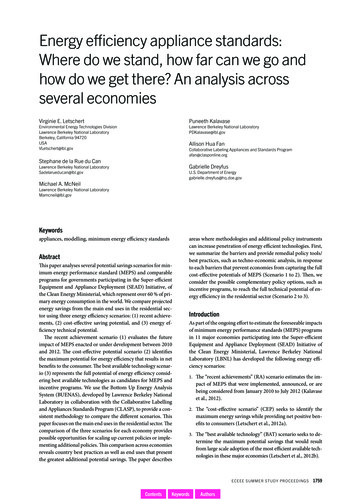
Transcription
Residential Property AssessedClean Energy (PACE) LoansAndrew G. Pizor, National Consumer Law CenterJanuary 17, 2018
About NCLERThe National Center on Law and Elder Rights (NCLER) providesthe legal services and aging and disability communities withthe tools and resources they need to serve older adults withthe greatest economic and social needs. A centralized, onestop shop for legal assistance, NCLER provides Legal Training,Case Consultations, and Technical Assistance on Legal SystemsDevelopment. Justice in Aging administers the NCLER througha contract with the Administration for Community Living’sAdministration on Aging.
Since 1969, the nonprofit National Consumer Law Center (NCLC ) hasused its expertise in consumer law and energy policy to work forconsumer justice and economic security for low-income and otherdisadvantaged people, including older adults, in the U.S.NCLC’s expertise includes policy analysis and advocacy; consumer law andenergy publications; litigation; expert witness services, and training andadvice for advocates. NCLC works with nonprofit and legal servicesorganizations, private attorneys, policymakers, and federal and stategovernment and courts across the nation to stop exploitative practices,help financially stressed families build and retain wealth, and advanceeconomic fairness.
Agenda Introduction & Overview of PACE Some Examples–Client Stories Problems with PACE Tips for Helping Seniors
Introduction This is a survey of PACE. It is not state specific. But most of what everyone knows about PACE sofar comes from California, because they were thefirst and remain the biggest PACE market. Focusing on experience of seniors and low-incomehomeowners. For state-specific information, call NCLC so we canhelp you find the appropriate contact in your state.
What is PACE? Property Assessed Clean Energy: A financing mechanism tohelp people pay for home improvements that increase ahome’s energy efficiency or achieves other public goals(water efficiency, storm resistance, etc.) It’s a loan and a property tax assessment, with a tax lien Funded by municipal bonds and Wall St. securitization Authorized by state law, opt-in by local governments Most privately run by contractors, minimal governmentoversight
Before: 2,920.81After: 15,211.30 (over 40% of the household’s gross income)
Authorizing PACE 1. A state adopts enabling legislation. 33 states so far–mostly commercial or inactive Active in California, Missouri, Florida Pending in various states 2. A local government (city, county or joint powers authority) decides tocreate a PACE program and contracts with a PACE “administrator” The PACE Administrator can be a public agency but is usually a privatecompany The administrator acts like the origination department of a mortgage bank. The local government is the source of the loan money (normally from municipalbond sales). Home improvement contractors are like the brokers or sales force for the loans.
PACE Administrators
Rapid Growth Since 2008, more than 132,000 loans have beenmade totaling approximately 3.3 billion, with 2.85 billion originated in the last two years. PACE industry forecasts that the current 3.3 billionin PACE financing will double within the next year,making it fastest-growing form of financing.
These Are High-Cost Loans Borrowers pay: Interest rates average from 6 to 9%, with APRs over 10%. Prime rate for 30-yr fixed-rate mortgages is currently 4%. Plus points and fees of at least 5% Annual administrative fee of about 35/yr Steep pre-payment penalties. Loans are 10-20 years Almost anyone who can afford credit can get better termselsewhere. Only helpful to persons with poor credit and just the right amount ofincome.
Example Ms. C. got a 39,676 PACEloan for solar panels 8.95 % rate, APR of 10.32 % Total of payments on 20-yearloan is 84,393 Annual assessment is 4,219.66 Her mortgage payment afterescrow adjustment increasedfrom 990 to 1,500 permonth
The Finance Side PACE is a goldmine: Inflated pricesMinimal underwriting costsMinimal servicing costs, no loss mitigationZERO RISK because of superpriority statusYet interest rates are twice that of conventional forprofit lenders Financed through public bonds, which are thensecuritized.
Collection Biggest threats: Reverse mortgages – nonpayment of property taxes mortgage escrow payment (impoundment) – shortage,cushion, payment shock Bond-holder can foreclose Tax lien sale Steep penalties for delinquent taxes apply. Usually takes several years to foreclose. California’s reserve fund protects pre-existinglienholders, not the homeowner.
Client Stories Two PACE liens for the exact same work (which is not done). Telling a senior with dementia that her home would be redtagged. Signing the contract and the completion certificate the sameday. Offering non-efficient improvements to coerce homeownersto sign-up, but only billing PACE admin for authorized items. Claiming that energy bills will not only be eliminated, butDWP will pay the homeowner for extra energy generated.
“It’s a Free Government Program” There are legitimate free government programs that lowincome homeowners often know about. Even where there is no direct misrepresentation, thegovernment affiliation inspires trust, including as to pricing. Participating in a program is different from negotiating a contract. Other key misrepresentations: Rebates Tax benefits Energy savings
“Affordable” Government “Partnerships”
Not Helping the Environment Contractors do not perform energy audits. Homeowners’ energy usage does not decrease. Most projects have no benefit Partial exception for solar panels No projects pay for themselves, as recommended by theDepartment of Energy Contractors perform non-qualifying work.
Contractors as Loan Brokers Do they understand how PACE works? Door-to-door solicitation “I’m here to talk to you about a County program;” Not “I’m here from ABC Contractors do you need financing” Robo-calls “We’ll do an assessment on your house to see what your houseneeds” “The City wants to reward you for paying you property taxes” They refuse to give a business name, and hang up
Brokering E-Contracts The finance application and assessment contractare presented on a tablet with e-signatures. There may be a phone call to verify basic terms. Contractors set up email accounts for seniors. Thesenior may not know how to access it, but thecontractor does. Paper copies are rarely sent (even if there is noemail listed on the contract).
Prices Are Out of Control Unsophisticated homeowners are targetedSense of trust because it’s a “program”Homeowners think it’s freeHomeowners never see the paperwork
Language & Race Documents are only provided in English E-signing amplifies this problem, with the homeownerfully relying on the representations made by thecontractor Targeting? One study says not targeting low-income Others suggest targeting neighborhoods of color Anecdotal evidence of targeting seniors
Waivers, Arbitration, Lack of Remedies By structuring PACE loans as tax assessments, PACE lendersseek to evade consumer protection laws (TILA, RESPA, FTCHolder rule, etc.) Original state enabling statutes lack any remedies orprotections New Cal. protections effective Jan. and Apr. 2017 Other states considering protections Assessment contracts include jury trial waiver, forcedarbitration clause, and a class action waiver Contracts also include broad releases of virtually all claimsrelated to the transaction
Example of PACE Eligibility (Cal.) Basic PACE Eligibility Requirements1. Loan (original SB 77 (2010) language; AB 2597 (2014)changed to financing) recipients are legal owners2. Recipients are current on mortgage and property taxpayments3. Recipients are not in default or in bankruptcy proceedings4. Financing for less than 15% of the value of the property upto 700,000, then 10% of the value above 700,0005. The property is within the PACE program areaCalifornia Streets and Highways Code § 5898.16(a)(2), referencing CaliforniaPublic Resources Code § 26063(a)
PACE Eligibility (cont.) Basic PACE Eligibility Requirements (continued)6.7.8.The program finances energy or water efficient improvementsProducts follow energy efficiency retrofit work standardsTotal mortgage-related debt and PACE financing do not exceedthe value of the propertyCalifornia Streets and Highways Code § 5898.16(a)(2) Annual property taxes and assessments cannot exceed fivepercent of the property valueCalifornia Streets and Highways Code § 5898.16(a)(1)
The Future of PACE PACE administrators claiming victory–will thelegislation allow PACE to expand without criticalprotections in place? Significant consumer protection gaps remain,leaving vulnerable homeowners at risk PACE is spreading to other states
Litigation StrategiesRecent decisions in class casesIn re Hero LitigationSmith v. YgreneIndividual litigationElder abuseBreach of contract & negligent supervisionAgency issuesDefending mechanic’s lien casesOther claims & considerations
In re Hero Loan Litigation Three class actions, in three counties, challenging excessivefees, the calculation of interest and prepayment penalties. Claims under TILA, HOEPA and California’s UPAP statute. “Because California's PACE assessments are taxassessments, because the CFPB has stated that taxassessments are not credit, and because this CFPB opinionas applied to PACE assessments is not demonstrablyirrational, PACE assessments are not credit so they are notsubject to regulation by TILA or HOEPA.” In re Hero Loan Litig., 2017 U.S. Dist. LEXIS 111771 (C.D. Cal. July 17,2017)
Smith v. Ygrene California’s Consumer Legal Remedies Act does notapply to intangible financial services.Impact for representing homeowners: Need to show that PACE Administrators have rolesbeyond that of lenders. Choosing what products qualify for financing Ensuring that only those products are installed Excellent fit with Civ. Code § 1770(a)(5) Smith v. Ygrene Energy Fund, Inc., No. 17-CV-01258-LB, 2017WL 3168519 (N.D. Cal. July 26, 2017)
These Two CasesIn re Hero LoanLitigation “It isn’t a loan so TILAand HOEPA don’tapply”Smith v. Ygrene “It’s a loan so theConsumer LegalRemedies Act doesn’tapply.”
Financial Elder Abuse Cal. Welf. & Inst. Code § 15600 et seq. Taking or assisting in taking the property of an elder If you know or should have known the taking was likely to harm theelder “Taking” includes any impairment of a property interest See Bounds v. Superior Court, 229 Cal. App. 4th 468 (2014). PACE Administrators “take” their own fees, They assist homeowners in “taking” the remainder. Section 15657.5 does not require fraud. Section 15657.6 does notrequire any wrongful intent Three potential claims: § 15657.5, § 15657.6, Prob. Code § 859. See alsoCiv. Code §§ 39, 3345
Contracts & Negligence(COUNTY)PACEADMINISTRATORCONTRACTORS Each of these contracts likely containsconsumer protections. Third party beneficiary claims undereach contract. Negligent supervision against (County)for failure to supervise PACE Admins? Check state immunity statute(s) Doe I v. Wal-Mart Stores, Inc., 572 F.3d677, 682 (9th Cir. 2009) Negligent supervision against PACEAdmin for failure to supervisecontractors.
Agency Issues
Beneficial Relationship Concentrate on agency as to the loan origination Not the home improvements Agency relationship tests will vary state by state Tell the story of the practical advantages to the Admins: Introducing the productPutting people on the phonePresenting documents electronically for signature, etc.“Appellant not only relies, but in fact depends on the teachers toact as its conduit to the students [and] is thus exploiting orenjoying the benefit of California’s schools and employees to obtainsales.” Scholastic Book Clubs, Inc. v. State Bd. Of Equalization, 207 Cal. App. 3d734 (1989).
Defending Mechanic’s Lien Cases Bring counterclaims Name the Admin Check the HIC contract Get the Admin’s copy ofthe HIC contracts
Other Theories & Considerations UDAP Taxpayer waste Delegation claims Home solicitationstatutes Contractor laws Phone banks: TCPA, TSR RICO Experts Ask your MortgageBankers Association Try to find an energyexpert Pay for an energy audit?
PACE Resources National Consumer Law Center PACE webpage: www.nclc.org/issues/pace-loans.html PACE listserv: http://lists.nclc.org/subscribe/ Energy Programs Consortium Residential Property Assessed Clean Energy (R-PACE) -- A Primer for State and Local EnergyOfficials (June 2017) Assessment of Low Income Homeowner Participation in the Property Assessed CleanEnergy (PACE) Program in California (November 2017) http://www.energyprograms.org/programs/pace/ PACENation (industry) http://pacenation.us Department of Energy Best Practice Guidelines for Residential PACE FinancingPrograms (voluntary): stpractice-guidelines-RPACE.pdf
Other Steps Send NCLC examples of consumer abuses and PACEprojects that are not cost-effective. Ask clients to submit complaints to the CFPB andtheir state regulator. Monitor changes to state law and local programrequirements.
Case ConsultationsCase consultation assistance is available for attorneysand professionals seeking more information to helpolder adults. Contact NCLER atConsultNCLER@acl.hhs.gov.
Authorizing PACE 1. A state adopts enabling legislation. 33 states so far-mostly commercial or inactive Active in California, Missouri, Florida Pending in various states 2. A local government (city, county or joint powers authority) decides to create a PACE program and contracts with a PACE "administrator"
